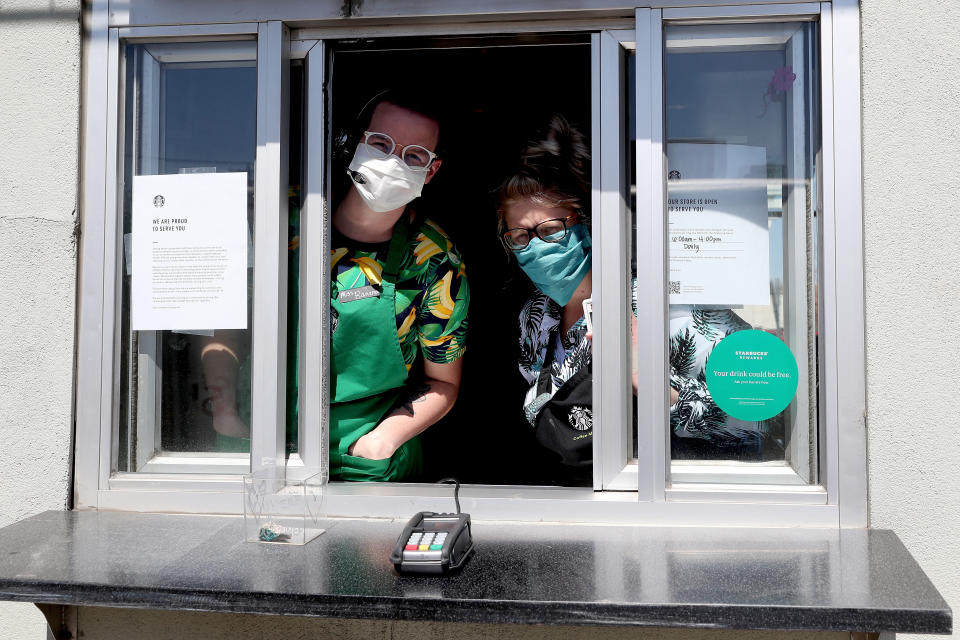Starbucks extends COVID-19 benefits through the end of May, sees 'new phase' for opening stores
Starbucks (SBUX) says it will now extend its temporary COVID-19 benefits for its U.S. employees, including higher hourly wages for those willing and able to work and catastrophe pay for those who can’t work through the end of May.
Starbucks was among the companies offering its employees catastrophe pay and said it would pay all of its employees, known internally as partners, regardless of whether they work or not through May 3. For those choosing to work, however, the coffee giant recently sweetened the hourly pay with an extra $3 per hour and will continue providing that premium through the end of May.
What’s more, if a partner’s home store is closed, they will have the option to work at a nearby location that’s open. To be sure, employees who are healthy, but unwilling to work after May 3, will no longer receive the catastrophe pay. However, the catastrophe pay will be available through the month of May for anyone who needs to stay home because of a diagnosis or need to self-isolate, or if their store needs to remain closed during that time, or if parents need to homeschool their children.
‘A New Phase’
On March 15, Starbucks suspended café seating and moved to a “to go” format in the U.S. A few days later, Starbucks pivoted to drive-thru and delivery only to adhere to social distancing. Approximately 60% of the 15,000 Starbucks stores in the U.S. offer drive-thru service. The coffee chain offers delivery in partnership with Uber Eats across 49 markets in the U.S.
Starbucks first saw an impact on its business from COVID-19 in China, its second-largest market. In January, the coffee giant had closed more than half of its stores 4,100 in mainland China. Presently, more 95% of the Starbucks stores in China are open, but many with modified hours and limited seating, according to a recent regulatory filing.

That experience in China has helped inform the decision-making in the U.S. In a letter to employees, CEO Kevin Johnson said they are “beginning to see progress.”
“As we have experienced in China, we are now transitioning to a new phase that can best be described as ‘monitor and adapt.’ This means every community will continue to monitor the COVID-19 situation, and people and businesses in that community will begin to adapt. Gradually, more schools and businesses will open,” Johnson wrote in a letter on Thursday to Starbucks more than 200,000 partners in the U.S.
As such, Starbucks will begin opening stores in modified formats, including continuing drive-thru only, while some stores will use mobile ordering for contactless pickup and delivery, and others will reopen for “to-go” ordering with entryway handoff.
“As we experienced in China, this will be a journey, and we are thoughtfully preparing for this next phase as we adapt in the U.S,” Johnson wrote.
These decisions will be made at an individual store level and guided by health and government officials, store operational readiness, community sentiment, and the local status of the health crisis.
“For Starbucks in the U.S., China and everywhere, there is a more important, final question: When and how? This is the unique responsibility Starbucks partners have to one another, to our customers and to our communities – do the right thing. Only by trying to exceed local, state and national health requirements will we be ready to serve our communities. Not all decisions are financial, and in a crisis like this, they must be secondary to the health and well-being of our partners and customers,” Johnson wrote.
Starbucks, which reports earnings on April 28, has said it expects earnings per share for the fiscal second quarter to come in at 28 cents, down 47% from 53 cents the same period a year ago, according to a regulatory filing released earlier this month.
The closely-followed comparable-store sales figure in the U.S. had been on track to deliver 8% growth for the first ten weeks of the quarter. Beginning March 12 same-store sales “steadily worsened” due to the pandemic and were down 3% during the quarter versus a year go, “reflecting the very rapid onset of COVID-19 business impacts in the final three weeks of the quarter.”
-
Julia La Roche is a Correspondent at Yahoo Finance. Follow her on Twitter.
